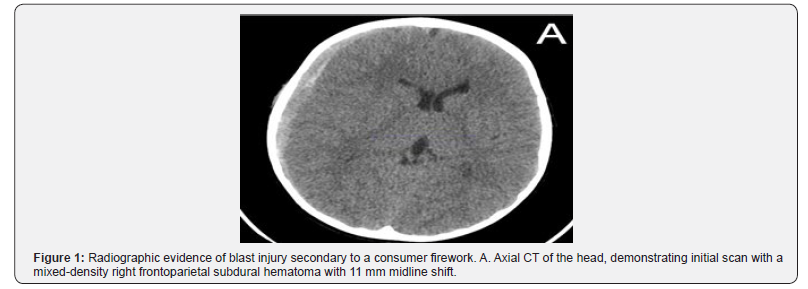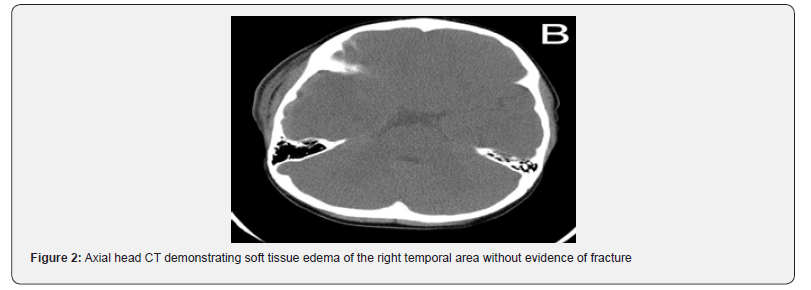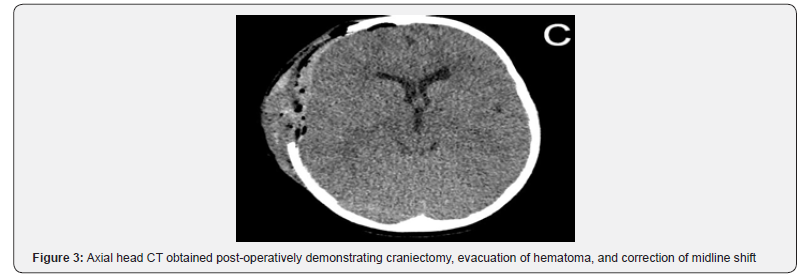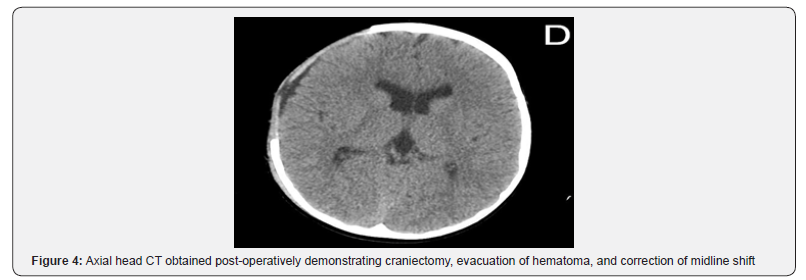Traumatic Subdural Hematoma and Intraparenchymal Contusion after a Firework Blast Injury-Juniper Publishers
Juniper Publishers-Open Access Journal of Head Neck & Spine Surgery
Traumatic Subdural Hematoma and Intraparenchymal Contusion after a Firework Blast Injury
Abstract
Firework injuries represent a common etiology of injury requiring emergency department evaluation every year, especially in the pediatric population. Typically, firework-related injuries tend to produce burn or blast injuries; however, there have been no reports of fireworks causing an intracranial hematoma. The authors report a case of a consumer firework directly impacting the head of a 6-year-old boy, causing neurological deterioration. Trauma evaluation discovered a subdural hematoma, for which the child underwent emergency hemicraniectomy for surgical evacuation. Despite the injury, he recovered with minimal neurologic sequelae. After one month, he returned for cranioplasty and experienced a favorable outcome after his traumatic brain injury with some mild cognitive deficits.
Keywords: Fireworks; Subdural hematoma; Traumatic brain injury
Abbrevations: GCS: Glasgow Coma Score; CT: Computed Tomography
Introduction
Firework displays are a frequently encountered and integral part of summertime holiday celebrations in the United States, although they do carry significant risk, especially in the pediatric population. Firework-related injuries comprise a small, yet significant, source of pediatric injury [1]. Since 1990, more than 5000 children were treated for consumer firework-related injuries in emergency rooms across the United States on an annual basis [2]. In 2014 alone, 10,500 firework-related injuries required hospital treatment [3]. While orthopedic and burn injuries to the hands compose the majority of these injuries, 22.0% of firework-related injuries involve the head or neck [2]. Furthermore, a significant percentage of these injuries are suffered by bystanders [3]. A small fraction of these injuries require hospitalization, and even fewer require operative intervention [4,5].
Pediatric brain injury due to projectile or explosive weapons in both civilian and military zones is well known [6-8]. While head injury caused by fireworks comprises approximately a fourth of all fireworks injury in children, there has not yet been a report in the literature of a firework impact causing an intracranial hemorrhage, much less an injury requiringemergency neurosurgical intervention. Herein we report a 6-year-old male bystander who suffered a consumer firework-related blast injury, requiring emergent hemicraniectomy for evacuation of a subdural caused by the fireworks impact.
Case Report
History and Examination
A 6-year-old boy with no significant past medical history was at a neighborhood party celebrating Independence Day. The boy was a bystander in a crowd when a large firework misfired and hit the boy in the right temple. Per report, the firework exploded on or around the time of impact. The boy reportedly lost consciousness briefly and was then transported to our institution
On initial presentation, the patient had a Glasgow Coma Score (GCS) of 14 with confusion regarding the year and his location, in addition to left lower extremity weakness. He had a 5 cm burn over his right temple with surrounding facial edema. Computed Tomography (CT) of the head demonstrated a 9mm mixed-density right convexity subdural hematoma with 11 mm of midline shift (Figure 1). No skull fracture was identified(Figure 2). While in the trauma bay, he had a steady decline in consciousness. Due to the large subdural seen on imaging and concordant worsening exam findings, the decision was made to proceed with surgical intervention for evacuation of the hematoma (Figure 3).



Operation
A right-sided front temporoparietal hemicraniectomy with evacuation of a significant subdural hematoma was performed. A temporal parenchymal contusion was noted as the likely culprit of the subdural blood. Due to substantial cerebral edema, the bone flap was not immediately replaced. A right frontalintraparenchymal pressure monitor was placed, and he was taken to the Pediatric Intensive Care Unit post-operatively. A post-operative head CT was performed, showing satisfactory evacuation of subdural hematoma and markedly improved midline shift (Figure 4).

Post-operative Course
His post-operative course was uneventful. Intracranial pressure remained within normal limits, and he briskly followed commands. On the first day following surgery, the intraparenchymal pressure monitoring device was removed, and he was extubated. He progressed well and was discharged on post-operative day 5. He returned 1 month after his initial injury for autologous cranioplasty and tolerated the procedure well without complications. At 5 months follow-up, he had returned to school with minor emotional outbursts and attention issues that were not present prior to injury.
Discussion
Fireworks, while a common part of many holiday celebrations in the United States, are an important etiology of pediatric injury. All common consumer fireworks have been known to cause injury, including death, incurring significant medical expenses [9]. However, significant firework-related neurological injury has not been previously reported in the literature. In the case discussed, we report a bystander child who incurred a serious neurological traumatic brain injury secondary to an aerial consumer firework used at a neighborhood firework display. Due to the severe injury, the child underwent a major surgery for evacuation of intracranial hematoma. Additionally, the patient required multiple days in the intensive care unit, required repeat admission for bone flap replacement, and had lasting cognitive effects
Surprisingly, firework-related injuries to pediatric bystanders is reported in 26% of all fireworks injury cases [4]. Greater than half of the reported cases include adult supervision, demonstrating that even adult supervision does not necessarily prevent these types of injuries [4]. Public education initiatives about the dangers of fireworks have also failed to translate tomeaningful changes in rates of pediatric fireworks injury [10]. The American Academy of Pediatrics has advocated for abolition of all consumer fireworks, encouraging attendance solely at public fireworks displays [11]. Given that consumer fireworks can cause pediatric head injury similar to that seen in weapon projectile or blast injury, as demonstrated in the case presented, this stance is reasonable [8].
Given the uncommon nature, traumatic brain injury secondary to cerebral blast injury may be missed on initial presentation, leading to a delay in diagnosis [12]. Recognition that consumer fireworks can cause these severe and potentially operative injuries is important in their overall treatment. The case reported here highlights the first reported case of severe traumatic brain injury and intracranial hemorrhage secondary to a firework-related injury, denoting the need for increased public knowledge of the danger of consumer fireworks
For more articles in Open access Journal of Head Neck & Spine Surgery | please click on: https://juniperpublishers.com/jhnss/index.php
For more about Juniper Publishers | please click on: https://juniperpublishers.com/pdf/Peer-Review-System.pdf

Comments
Post a Comment